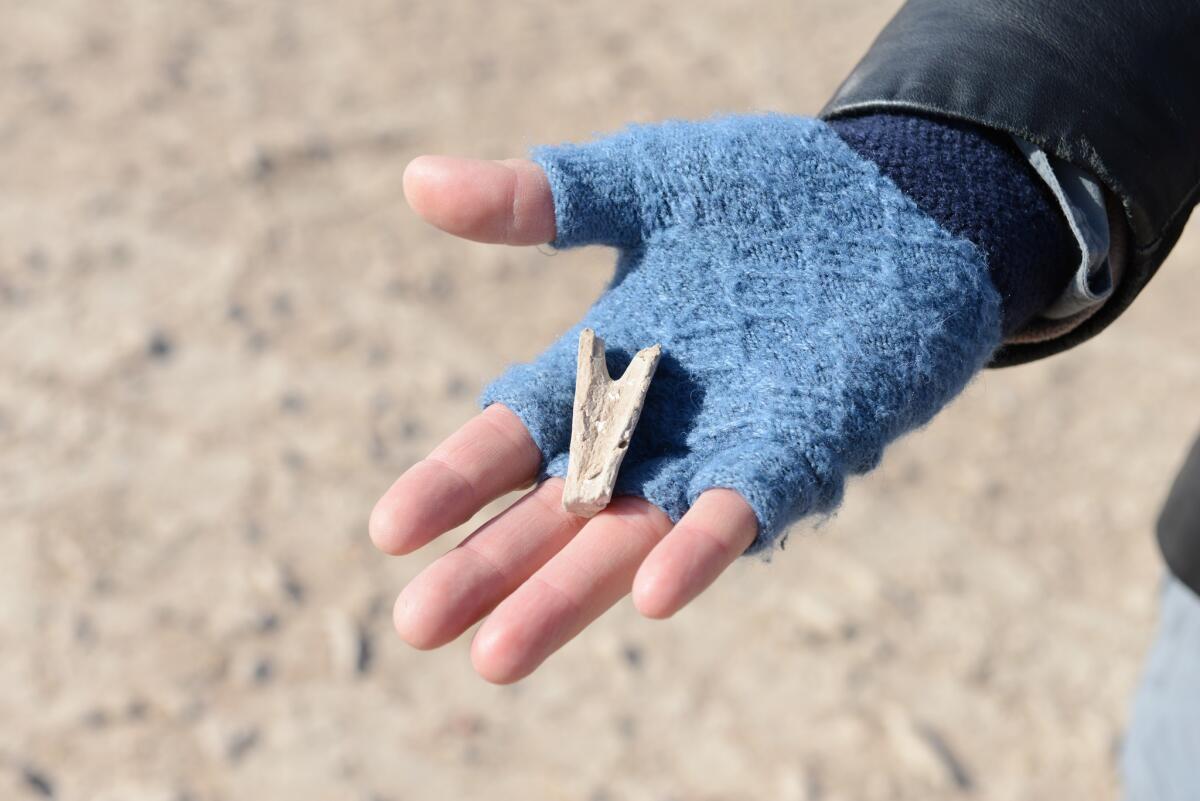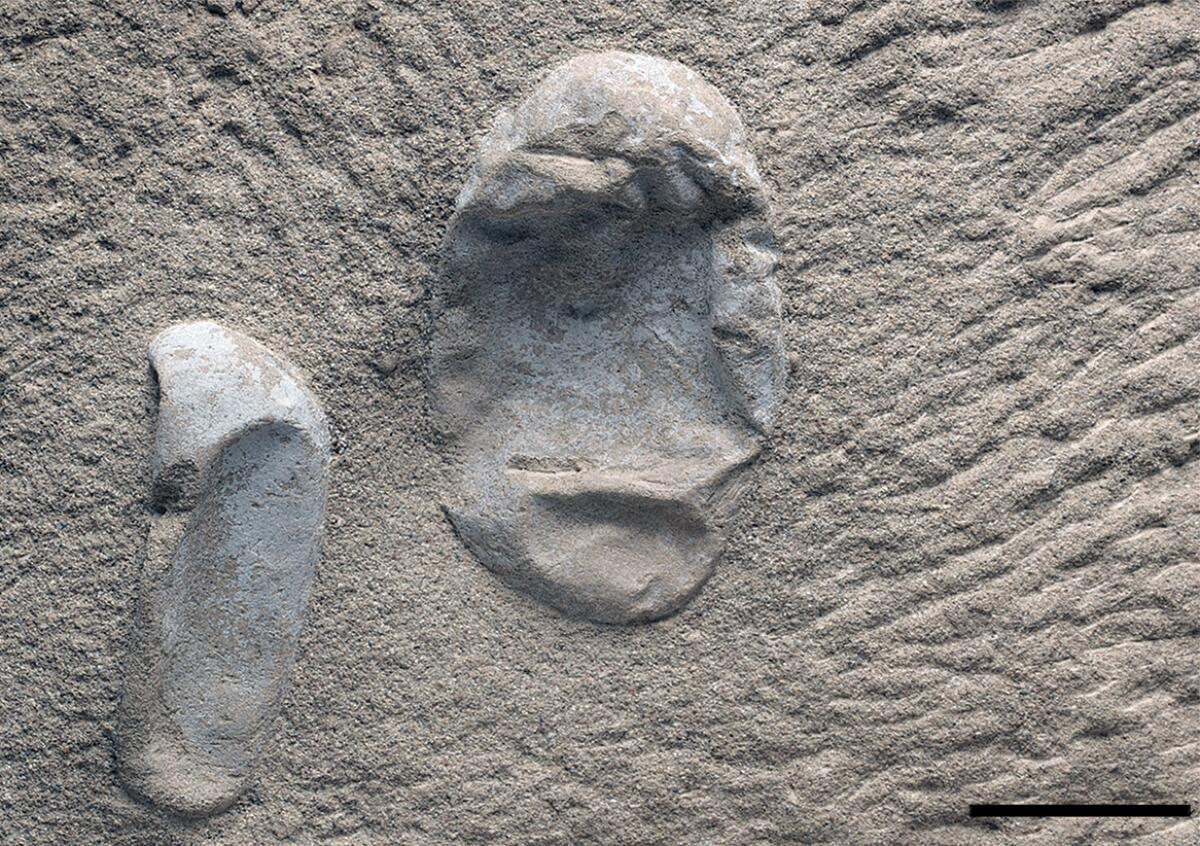These 215 fossil pterosaur eggs are revealing new clues about these mysterious flying reptiles
- Share via
A team of Chinese and Brazilian scientists has discovered a collection of hundreds of fossilized pterosaur eggs — many of which retained their three-dimensional shape, and some of which even have tiny embryos inside.
The find, described in the journal Science, offers an unprecedented look at the early development of these ancient flying reptiles.
“It’s just such a beautiful discovery,” said Luis Chiappe, a paleontologist with the Natural History Museum of Los Angeles County who was not involved in the study. “These things are so rare.”
Pterosaurs are not dinosaurs, but flying reptiles whose existence overlapped with their fellow extinct cousins. They lived from the late Triassic to the end of the Cretaceous (roughly 228 million to 66 million years ago). They’re the earliest known vertebrates to have developed powered flight — tens of millions of years before birds arose from dinosaurs — and different species ranged in size from that of an F-16 fighter jet to a paper airplane, according to the American Museum of Natural History.
But even though this group of animals thrived for millions of years, they’re not as well documented as the dinosaurs are. That’s in part because pterosaurs have very fragile, lightweight bones. That’s great for flying, Chiappe pointed out, but not so great for weathering millions of years in the fossil record.
Very little is known about these reptiles’ reproductive stages, and what their young were like. Scientists have discovered a number of fossil dinosaur eggs, and found that the large marine reptiles called ichthyosaurs actually gave birth to live young.
But the biology and development of pterosaurs, even with the discovery of a handful of non-flattened eggs in recent years, has remained something of an enigma. That’s partly because previous egg finds were found in spots where it was difficult to tell if all the bones belonged to the exact same species.
But a mother lode of hundreds of eggs and bones discovered in a sandstone block in northwestern China may finally paint a fuller picture of these animals at the earliest stage of their lives. All the specimens seem to be roughly 120 million years old, dating back to the Early Cretaceous period , and appear to belong to the same species: a midsized crested pterosaur called Hamipterus tianshanensis.
These eggs appear to have been moved before they were fossilized, perhaps by storm-fed floodwaters from a nearby river, said Alexander Kellner, one of the study’s lead authors and a paleontologist at Museu Nacional–Universidade Federal do Rio de Janeiro in Brazil. The researchers counted 215 eggs but there may be up to 300, given how the eggs are piled on top of each other.
The eggs show some cracking as well as crazing (the fine network of fractures often seen on glazed pottery). All of them are deformed to some degree — which means they were probably soft the way that lizard eggs typically are, not hard and protected by a relatively thick layer of calcium carbonate like those of birds, crocodiles and dinosaurs. These eggs were more likely to be squashed than shattered.

Because their eggs lacked this protective armor, pterosaurs probably buried their eggs so that they could stay warm and moist. It could explain why there were so many eggs in one place, D. Charles Deeming of the University of Lincoln in England, who was not involved in the paper, wrote in a commentary.
“Appropriate nesting environments may have been rare, forcing pterosaurs to adopt colonial nesting through necessity — but it was not without risk,” he wrote. “Modern sea turtles nest colonially, but while preparing their own nests, females may inadvertently damage previously dug nests and expose eggs to predators.”
It could also explain the damage to some of the eggs, he pointed out.
“Perhaps the dimpled pterosaur eggs reported in [the paper] indicate that Hamipterus also experienced nest damage through intraspecific competition for limited nesting sites,” Deeming wrote.
Sixteen of the eggs had partial embryos within them, some of which had varying numbers of small, almost needle-thin bones. It’s hard to say whether that variation is because some eggs were at different stages of development, or were preserved more effectively, or lost when they were moved and buried, the study authors said.
Still, these tiny bones offer some tantalizing clues, which the researchers uncovered as they subjected the eggs to CT scans and peered at the structure of tiny bone samples under a microscope.

For example, some bones related to flight (such as the humerus) were underdeveloped, while the femurs (their hind limb bones) looked pretty strong — meaning that when they hatched, these baby pterosaurs probably hopped around and were not ready for flight.
“Newborns were likely to move around but were not able to fly, leading to the hypothesis that Hamipterus might have been less precocious than advocated for flying reptiles in general and probably needed some parental care,” the study authors wrote.
Many reptiles today are known for laying their eggs and then walking (or crawling, or slithering) away, never to see them again. But the new results imply that these prehistoric flying reptiles’ parenting duties may have been at least a little more involved.
The findings also seem to suggest that pterosaurs returned faithfully to the same site to lay eggs over time, Kellner said.
“Overall the conditions at that site for laying the eggs was good — except for some times when you had those big storms that essentially washed the nesting site and removed all the eggs or part of the eggs,” Kellner said. “But it must have worked for some times, otherwise they wouldn’t be going there.”
More fieldwork at the site, he added, could help them determine what those attractive qualities were: whether it was the available food or vegetation, or whether there were other factors at play, too.
Still, this is just one set of specimens, and there are a lot of questions that remain unanswered, Deeming pointed out.
“Were the eggs buried in sand or covered in vegetation? Was clutch size limited to two? Why are so many of the eggs showing signs of dehydration?” Deeming wrote. “Hopefully additional finds of equally spectacular fossils will help us answer such questions for pterosaurs and allow us to paint an increasingly complete picture of reproduction in these extinct species.”
Chiappe said he expected that as researchers further probed this site, they’d come up with even more discoveries that could shed light on the lives of these pterosaurs.
“When you find a site like this, and a discovery like this, it’s usually the beginning of a much lengthier process of research,” he pointed out. “This is the tip of the iceberg.”
The next step, Kellner said, is to find eggs in their original, undisturbed site, not moved as these eggs had been. That’s because fossil’s original rocky context can allow researchers to better understand the environment in which an animal died, and get a more precise gauge of when it lived.
“I think we have a good chance,” he said. “One day we’re gonna find it. It’s a question just of field work.”
Follow @aminawrite on Twitter for more science news and "like" Los Angeles Times Science & Health on Facebook.
MORE IN SCIENCE
DNA analysis solves the ‘Yeti’ mystery: They’re bears
Your spouse may drive you crazy, but your marriage might keep you from losing your mind
UPDATES:
3:50 p.m.: This story was updated with information from paleontologists Alexander Kellner and Luis Chiappe.
This article was originally published at 11:40 a.m.




